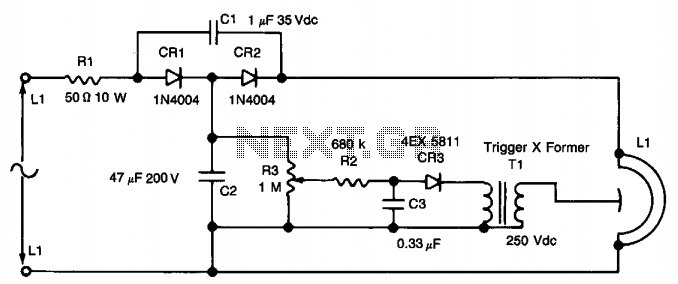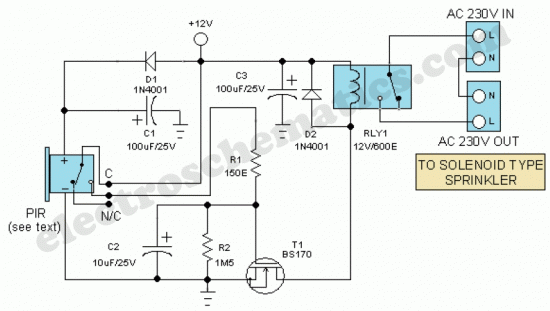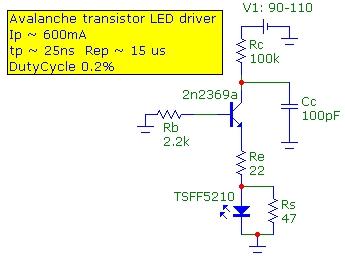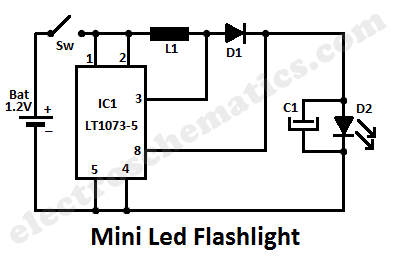
Disco-strobe light

This circuit employs a voltage doubler configuration using diodes CR1 and CR2 to achieve approximately 280 V DC across capacitor C1. Capacitor C2 and resistor R3 create a voltage divider to produce a DC voltage that charges capacitor C3 through resistor R2. Additionally, when diode CR3 conducts, a high voltage is induced in transformer T1, which subsequently triggers inductor L1.
The circuit operates on the principle of voltage doubling, where the diodes CR1 and CR2 are arranged to rectify and double the input AC voltage. The configuration allows the circuit to efficiently convert low-voltage AC into a higher DC voltage suitable for various applications. Capacitor C1 stores the high voltage, while the voltage divider formed by C2 and R3 is essential for regulating the output voltage to a desired level.
Capacitor C2 plays a crucial role in stabilizing the voltage across the divider, ensuring that the output remains consistent despite variations in load or input voltage. Resistor R3 serves to limit the current flowing through the divider, protecting the components from potential overloads.
The charging of capacitor C3 through resistor R2 indicates its function in smoothing the output voltage, providing a more stable DC supply. The timing of the charging process is influenced by the values of R2 and C3, which can be adjusted to tailor the response time and output characteristics of the circuit.
Furthermore, the activation of diode CR3 introduces a critical event in the circuit's operation. When CR3 conducts, it allows the high voltage from transformer T1 to be transferred to inductor L1. This process is vital for applications requiring inductive kickback or energy storage, as L1 can store energy and release it when needed, enhancing the overall efficiency of the circuit.
In summary, this circuit design effectively utilizes a voltage doubler and additional components to generate a high DC voltage while incorporating voltage regulation and energy storage features. The interplay between capacitors, resistors, and inductors creates a robust system that can be adapted for various electronic applications.This circuit uses a voltage doubler CR1 and CR2 to obtain about 280 V dc across Cl. C2 and R3 form a voltage divider to obtain a dc voltage to change C3 thru R2. When CR3 fires, a high voltage is generated in Tl, firing LI.
The circuit operates on the principle of voltage doubling, where the diodes CR1 and CR2 are arranged to rectify and double the input AC voltage. The configuration allows the circuit to efficiently convert low-voltage AC into a higher DC voltage suitable for various applications. Capacitor C1 stores the high voltage, while the voltage divider formed by C2 and R3 is essential for regulating the output voltage to a desired level.
Capacitor C2 plays a crucial role in stabilizing the voltage across the divider, ensuring that the output remains consistent despite variations in load or input voltage. Resistor R3 serves to limit the current flowing through the divider, protecting the components from potential overloads.
The charging of capacitor C3 through resistor R2 indicates its function in smoothing the output voltage, providing a more stable DC supply. The timing of the charging process is influenced by the values of R2 and C3, which can be adjusted to tailor the response time and output characteristics of the circuit.
Furthermore, the activation of diode CR3 introduces a critical event in the circuit's operation. When CR3 conducts, it allows the high voltage from transformer T1 to be transferred to inductor L1. This process is vital for applications requiring inductive kickback or energy storage, as L1 can store energy and release it when needed, enhancing the overall efficiency of the circuit.
In summary, this circuit design effectively utilizes a voltage doubler and additional components to generate a high DC voltage while incorporating voltage regulation and energy storage features. The interplay between capacitors, resistors, and inductors creates a robust system that can be adapted for various electronic applications.This circuit uses a voltage doubler CR1 and CR2 to obtain about 280 V dc across Cl. C2 and R3 form a voltage divider to obtain a dc voltage to change C3 thru R2. When CR3 fires, a high voltage is generated in Tl, firing LI.





